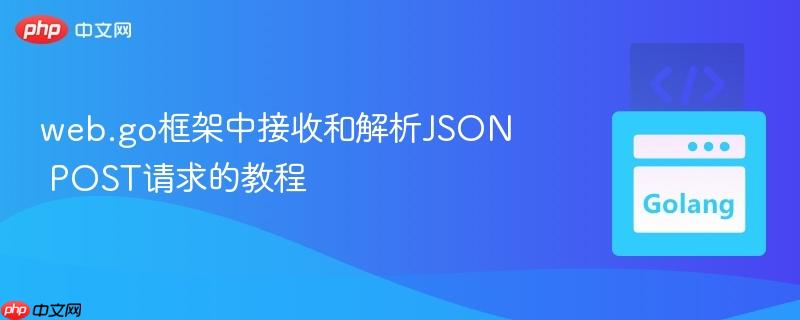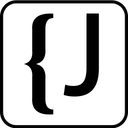
本文将指导您如何在web.go框架中正确接收和解析post请求中的json数据。由于`ctx.params`仅处理表单数据,对于原始json请求体无效,您需要直接通过`ctx.body`读取原始请求流,并结合go标准库的`encoding/json`包进行反序列化,从而有效处理客户端发送的json负载。
在使用web.go框架构建Web API时,开发者经常需要处理客户端通过POST请求发送的JSON数据。然而,一个常见的误区是尝试通过ctx.Params来访问JSON请求体。web.go框架(特别是hoisie/web库)在处理POST请求时,其ctx.Params对象主要用于解析URL路径参数或application/x-www-form-urlencoded以及multipart/form-data类型的表单数据。
根据web.go的内部实现,它会调用req.ParseForm()来解析请求体中的表单数据,并将其键值对填充到ctx.Params中。这意味着,如果客户端发送的是application/json类型的原始JSON请求体,ctx.Params将无法获取到这些数据,因为JSON不是标准的表单格式。
要正确获取POST请求中的原始JSON数据,我们需要直接访问HTTP请求的原始请求体。在web.go的Context对象中,ctx.Body字段提供了对底层*http.Request的Body字段的访问。ctx.Body是一个io.ReadCloser接口,允许我们读取请求的原始字节流。
以下是处理JSON请求体的标准步骤:
让我们通过一个完整的示例来演示如何在web.go中接收和解析JSON POST请求。
首先,确保你的Go项目中安装了web.go库:
go get github.com/hoisie/web
然后,创建main.go文件并添加以下代码:

Easily find JSON paths within JSON objects using our intuitive Json Path Finder
 30
30

package main
import (
"encoding/json"
"fmt"
"io/ioutil" // 用于读取请求体
"log" // 用于错误日志
"net/http" // 引入http包,虽然web.go封装了,但了解底层有帮助
"github.com/hoisie/web"
)
// RequestPayload 定义了期望的JSON请求体结构
type RequestPayload struct {
Apple int `json:"apple"`
Lettuce int `json:"lettuce"`
Message string `json:"message"`
}
// handleJSONPost 处理接收JSON数据的POST请求
func handleJSONPost(ctx *web.Context) {
// 1. 读取原始请求体
body, err := ioutil.ReadAll(ctx.Request.Body) // ctx.Request.Body 实际上就是 ctx.Body
if err != nil {
log.Printf("Error reading request body: %v", err)
ctx.Abort(http.StatusInternalServerError, "Failed to read request body")
return
}
defer ctx.Request.Body.Close() // 确保请求体被关闭
// 2. 将JSON数据反序列化到Go结构体
var payload RequestPayload
err = json.Unmarshal(body, &payload)
if err != nil {
log.Printf("Error unmarshaling JSON: %v", err)
ctx.Abort(http.StatusBadRequest, "Invalid JSON format")
return
}
// 3. 处理解析后的数据
fmt.Printf("Received JSON Payload: %+v\n", payload)
responseMessage := fmt.Sprintf("Successfully processed data: Apple=%d, Lettuce=%d, Message='%s'", payload.Apple, payload.Lettuce, payload.Message)
// 4. 构建并发送JSON响应
responseMap := map[string]string{"status": "success", "message": responseMessage}
jsonResponse, err := json.Marshal(responseMap)
if err != nil {
log.Printf("Error marshaling response JSON: %v", err)
ctx.Abort(http.StatusInternalServerError, "Failed to generate response")
return
}
ctx.ContentType("application/json") // 设置响应头
ctx.Write(jsonResponse) // 写入JSON响应
}
func main() {
// 注册POST请求路由,匹配所有路径
web.Post("/(.*)", handleJSONPost)
// 启动Web服务器
fmt.Println("Server starting on 0.0.0.0:9999")
web.Run("0.0.0.0:9999")
}运行上述代码:
go run main.go
服务器将在0.0.0.0:9999上启动。你可以使用curl或其他HTTP客户端工具发送POST请求:
curl -X POST -H "Content-Type: application/json" -d '{"apple": 10, "lettuce": 20, "message": "Hello from client!"}' http://localhost:9999/api/data服务器控制台将输出:
Received JSON Payload: {Apple:10 Lettuce:20 Message:Hello from client!}客户端将收到类似以下内容的JSON响应:
{"message":"Successfully processed data: Apple=10, Lettuce=20, Message='Hello from client!'","status":"success"}通过遵循上述指南和示例,你可以在web.go框架中有效地处理和解析POST请求中的JSON数据,构建功能完善的Web API。
以上就是web.go框架中接收和解析JSON POST请求的教程的详细内容,更多请关注php中文网其它相关文章!

每个人都需要一台速度更快、更稳定的 PC。随着时间的推移,垃圾文件、旧注册表数据和不必要的后台进程会占用资源并降低性能。幸运的是,许多工具可以让 Windows 保持平稳运行。




Copyright 2014-2025 https://www.php.cn/ All Rights Reserved | php.cn | 湘ICP备2023035733号